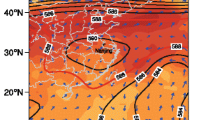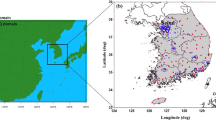Abstract
Anthropogenic heat emissions (AHE) play an important role in modulating the atmospheric thermodynamic and kinetic properties within the urban planetary boundary layer, particularly in densely populated megacities like Beijing. In this study, we estimate the AHE by using a Large-scale Urban Consumption of energY (LUCY) model and further couple LUCY with a high-resolution regional chemical transport model to evaluate the impact of AHE on atmospheric environment in Beijing. In areas with high AHE, the 2-m temperature (T2) increased to varying degrees and showed distinct diurnal and seasonal variations with maxima in night and winter. The increase in 10-m wind speed (WS10) and planetary boundary layer height (PBLH) exhibited slight diurnal variations but showed significant seasonal variations. Further, the systematic continuous precipitation increased by 2.1 mm due to the increase in PBLH and water vapor in upper air. In contrast, the precipitation in local thermal convective showers increased little because of the limited water vapor. Meanwhile, the PM2.5 reduced in areas with high AHE because of the increase in WS10 and PBLH and continued to reduce as the pollution levels increased. In contrast, in areas where prevailing wind direction was opposite to that of thermal circulation caused by AHE, the WS10 reduced, leading to increased PM2.5. The changes of PM2.5 illustrated that a reasonable AHE scheme might be an effective means to improve the performance of PM2.5 simulation. Besides, high AHE aggravated the O3 pollution in urban areas due to the reduction in NOx.

Similar content being viewed by others
References
Allen L, Lindberg F, Grimmond C S B (2011). Global to city scale urban anthropogenic heat flux: Model and variability. International Journal of Climatology, 31(13): 1990–2005
Bernardet L R, Grasso L D, Nachamkin J E, Finley C A, Cotton W R (2000). Simulating convective events using a high-resolution mesoscale model. Journal of Geophysical Research, 105(D11): 14963–14982
Bohnenstengel S I, Hamilton I, Davies M, Belcher S E (2014). Impact of anthropogenic heat emissions on London’s temperatures. Quarterly Journal of the Royal Meteorological Society, 140(679): 687–698
Bueno B, Pigeon G, Norford L K, Zibouche K, Marchadier C (2012). Development and evaluation of a building energy model integrated in the TEB scheme. Geoscientific Model Development, 5(2): 433–448
Crutzen P J (2004). New directions: The growing urban heat and pollution “island” effect—impact on chemistry and climate. Atmospheric Environment, 38(21): 3539–3540
Davy R, Esau I (2016). Differences in the efficacy of climate forcings explained by variations in atmospheric boundary layer depth. Nature Communications, 7: 11690
Ding D, Xing J, Wang S X, Liu K Y, Hao J M (2019). Estimated contributions of emissions controls, meteorological factors, population growth, and changes in baseline mortality to reductions in ambient PM2.5 and PM2.5-related mortality in China, 2013–2017. Environmental Health Perspectives, 127(6): 067009-1-12
Feng J M, Wang J, Yan Z W (2014). Impact of anthropogenic heat release on regional climate in three vast urban agglomerations in China. Advances in Atmospheric Sciences, 31(2): 363–373
Flanner M G (2009). Integrating anthropogenic heat flux with global climate models. Geophysical Research Letters, 36(2): L02081
Fu X, Wang S X, Zhao B, Xing J, Cheng Z, Liu H, Hao J M (2013). Emission inventory of primary pollutants and chemical speciation in 2010 for the Yangtze River Delta region, China. Atmospheric Environment, 70: 39–50
Gabey A M, Grimmond C S B, Capel-Timms I (2019). Anthropogenic heat flux: Advisable spatial resolutions when input data are scarce. Theoretical and Applied Climatology, 135: 791–807
Grimmond C S B (1992). The suburban energy-balance methodological considerations and results for a mid-latitude west coast city under winter and spring conditions. International Journal of Climatology, 12(5): 481–497
Gui K, Che H, Wang Y, Wang H, Zhang L, Zhao H, Zheng Y, Sun T, Zhang X (2019). Satellite-derived PM2.5 concentration trends over Eastern China from 1998 to 2016: Relationships to emissions and meteorological parameters. Environment Pollution, 247: 1125–1133
Hamilton I G, Davies M, Steadman P, Stone A, Ridley I, Evans S (2009). The significance of the anthropogenic heat emissions of London’s buildings: A comparison against captured shortwave solar radiation. Building and Environment, 44(4): 807–817
Iamarino M, Beevers S, Grimmond C S B (2012). High-resolution (space, time) anthropogenic heat emissions: London 1970–2025. International Journal of Climatology, 32(11): 1754–1767
Ichinose T, Shimodozono K, Hanaki K (1999). Impact of anthropogenic heat on urban climate in Tokyo. Atmospheric Environment, 33(24–25): 3897–3909
IPCC Climate Change 2013 (2013). The Physical Science Basis. Contribution of Working Group I to the Fifth Assessment Report of the Intergovernmental Panel on Climate Change. Cambridge: Cambridge University Press
Kikegawa Y, Genchi Y, Yoshikado H, Kondo H (2003). Development of a numerical simulation system toward comprehensive assessments of urban warming countermeasures including their impacts upon the urban buildings’ energy-demands. Applied Energy, 76(4): 449–466
Lee S H, Song C K, Baik J J, Park S U (2009). Estimation of anthropogenic heat emission in the Gyeong—In region of Korea. Theoretical and Applied Climatology, 96(3–4): 291–303
Li Y Y, Yu R C, Fu Y F, Ye C Z (2009). A case study on triggering of thermal convective precipitation. Acta Meteorologica Sinica, 66(2): 190–202
Miao Y, Liu S, Guo J, Huang S, Yan Y, Lou M (2018). Unraveling the relationships between boundary layer height and PM2.5 pollution in China based on four-year radiosonde measurements. Environment Pollution, 243(Pt B): 1186–1195
Petäjä T, Järvi L, Kerminen V M, Ding A J, Sun J N, Nie W, Kujansuu J, Virkkula A, Yang X Q, Fu C B, Zilitinkevich S, Kulmala M (2016). Enhanced air pollution via aerosol-boundary layer feedback in China. Scientific Reports, 6(1): 18998
Pielke R A (2001). Influence of the spatial distribution of vegetation and soils on the prediction of cumulus convective rainfall. Reviews of Geophysics, 39(2): 151–177
Pleim J E (2007a). A combined local and nonlocal closure model for the atmospheric boundary layer. Part I: model description and testing. Journal of Applied Meteorology and Climatology, 46(9): 1383–1395
Pleim J E (2007b). A combined local and nonlocal closure model for the atmospheric boundary layer. Part II: Application and evaluation in a mesoscale meteorological model. Journal of Applied Meteorology and Climatology, 46(9): 1396–1409
Pleim J E, Gilliam R (2009). An indirect data assimilation scheme for deep soil temperature in the Pleim-Xiu land surface model. Journal of Applied Meteorology and Climatology, 48(7): 1362–1376
Pleim J E, Xiu A J (1995). Development and testing of a surface flux and planetary boundary layer model for application in mesoscale models. Journal of Applied Meteorology and Climatology, 34(1): 16–32
Pleim J E, Xiu A J (2003). Development of a land surface model. Part II: data assimilation. Journal of Applied Meteorology and Climatology, 42: 1811–1822
Qu Y W, Han Y, Wu Y H, Gao P, Wang T J (2017). Study of PBLH and its correlation with particulate matter from one-year observation over Nanjing, Southeast China. Remote Sensing, 9: 668
Ryu Y H, Baik J J (2013). Daytime local circulations and their interactions in the Seoul metropolitan area. Journal of Applied Meteorology and Climatology, 52(4): 784–801
Sailor D J, Lu L (2004). A top-down methodology for developing diurnal and seasonal anthropogenic heating profiles for urban areas. Atmospheric Environment, 38(17): 2737–2748
Smith C, Lindley S, Levermore G (2009). Estimating spatial and temporal patterns of urban anthropogenic heat fluxes for UK cities: The case of Manchester. Theoretical and Applied Climatology, 98(1–2): 19–35
Tao H R, Xing J, Zhou H S, Chang X, Li G J, Chen L, Li J H (2018). Impacts of land use and land cover change on regional meteorology and air quality over the Beijing-Tianjin-Hebei region, China. Atmospheric Environment, 189: 9–21
Tao H R, Xing J, Zhou H S, Pleim J, Ran L M, Chang X, Wang S X, Chen F, Chen L, Zheng H T, Li J H (2020). Impacts of improved modeling resolution on the simulation of meteorology, air quality, and human exposure to PM2.5, O3 in Beijing, China. Journal of Cleaner Production, 243: 118574
Tao H R, Zhou H S, Xiong C H (2012). Numerical simulation study of surface fluxes effects on different types of precipitation based on AREM. Torrential Rain and Disasters-Chinese Ed, 31(2): 107–115
Wang Y, Shi M S, Lv Z F, Liu H, He K B (2021). Local and regional contributions to PM2.5 in the Beijing 2022 Winter Olympics infrastructure areas during haze episodes. Frontiers of Environmental Science & Engineering, 15(6): 140
Wu K, Yang X Q (2013). Urbanization and heterogeneous surface warming in eastern China. Chinese Science Bulletin, 58(12): 1363–1373
Xie M, Zhu K G, Wang T J, Yang H M, Zhuang B L, Li S, Li M G, Zhu X S, Ouyang Y (2014). Application of photochemical indicators to evaluate ozone nonlinear chemistry and pollution control counter-measure in China. Atmospheric Environment, 99: 466–473
Xiu A J, Pleim J E (2001). Development of a land surface model. Part I: Application in a mesoscale meteorological model. Journal of Applied Meteorology, 40(2): 192–209
Zhang R, Wang G, Guo S, Zamora M L, Ying Q, Lin Y, Wang W, Hu M, Wang Y (2015). Formation of urban fine particulate matter. Chemical Reviews, 115(10): 3803–3855
Zhao B, Jiang J H, Gu Y, Diner D, Worden J, Liou K N, Su H, Xing J, Garay M, Huang L (2017). Decadal-scale trends in regional aerosol particle properties and their linkage to emission changes. Environmental Research Letters, 12(5): 054021
Zhao B, Wang S X, Liu H, Xu J Y, Fu K, Klimont Z, Hao J M, He K B, Cofala J, Amann M (2013). NOx emissions in China: Historical trends and future perspectives. Atmospheric Chemistry and Physics, 13(19): 9869–9897
Zheng H T, Zhao B, Wang S, Wang T, Ding D, Chang X, Liu K, Xing J, Dong Z, Aunan K, Liu T, Wu X, Zhang S, Wu Y (2019b). Transition in source contributions of PM2.5 exposure and associated premature mortality in China during 2005–2015. Environment International, 132: 105111
Zheng H T, Cai S Y, Wang S X, Zhao B, Chang X, Hao J M (2019a). Development of a unit-based industrial emission inventory in the Beijing-Tianjin-Hebei region and resulting improvement in air quality modeling. Atmospheric Chemistry and Physics, 19: 3447–3462
Zhou T J, Yu R C (2005). Atmospheric water vapor transport associated with typical anomalous summer rainfall patterns in China. Journal of Geophysical Research, 110(D8): D08104
Acknowledgements
This work was supported in part by the National Key R&D Program of China (Grant No. 2018YFC0213502), the National Natural Science Foundation of China (Grant No. 41907190), and the Beijing Municipal Commission of Science and Technology (No. Z19110000119004). We acknowledge the Tsinghua National Laboratory for Information Science and Technology for providing access to the “Explorer 100” cluster system.
Author information
Authors and Affiliations
Corresponding authors
Additional information
Highlights
• The Large scale Urban Consumption of energY model was updated and coupled with WRF.
• Anthropogenic heat emissions altered the precipitation and its spatial distribution.
• A reasonable AHE scheme could improve the performance of simulated PM2.5.
• AHE aggravated the O3 pollution in urban areas.
Electronic Supplementary Material
11783_2021_1478_MOESM1_ESM.pdf
Impact of anthropogenic heat emissions on meteorological parameters and air quality in Beijing using a high-resolution model simulation
Rights and permissions
About this article
Cite this article
Tao, H., Xing, J., Pan, G. et al. Impact of anthropogenic heat emissions on meteorological parameters and air quality in Beijing using a high-resolution model simulation. Front. Environ. Sci. Eng. 16, 44 (2022). https://doi.org/10.1007/s11783-021-1478-3
Received:
Revised:
Accepted:
Published:
DOI: https://doi.org/10.1007/s11783-021-1478-3




